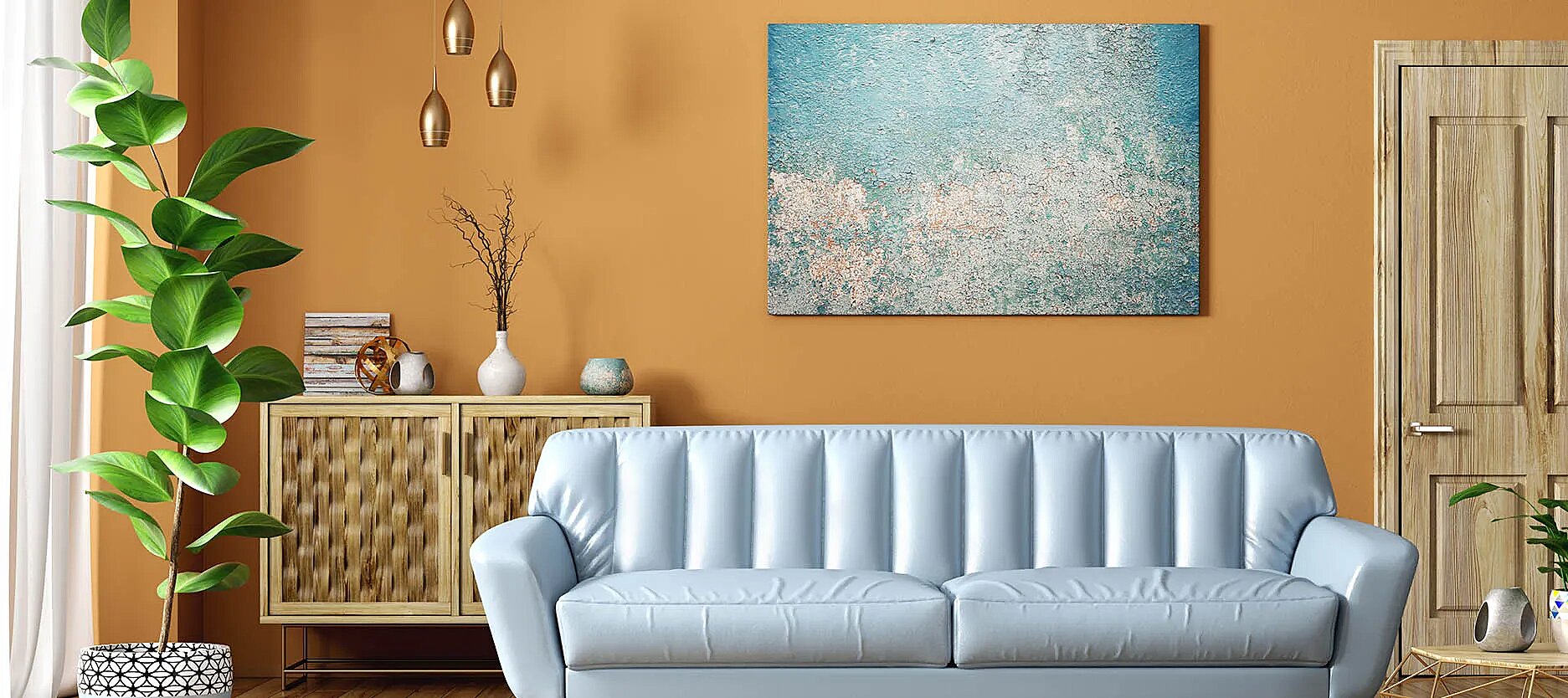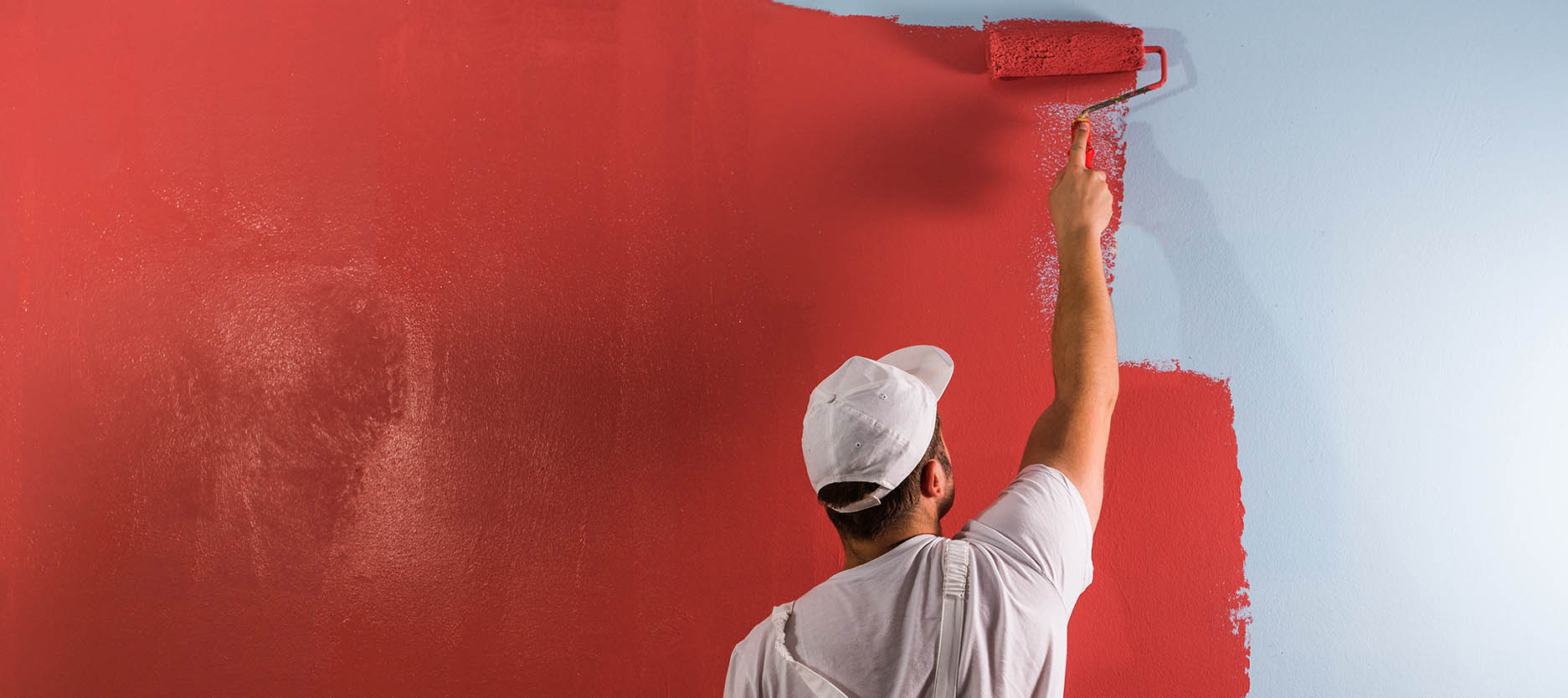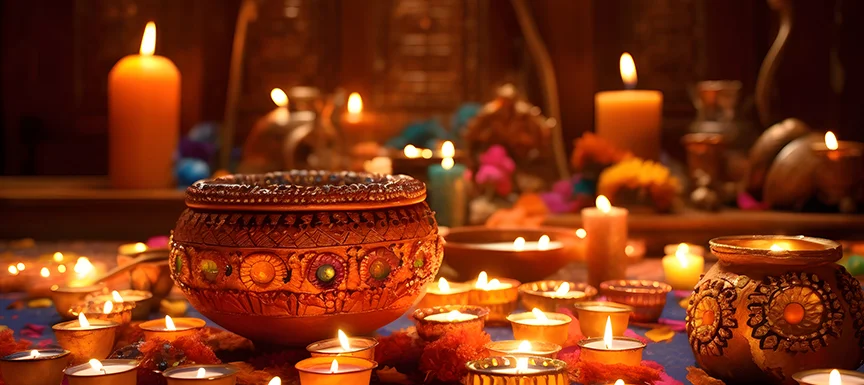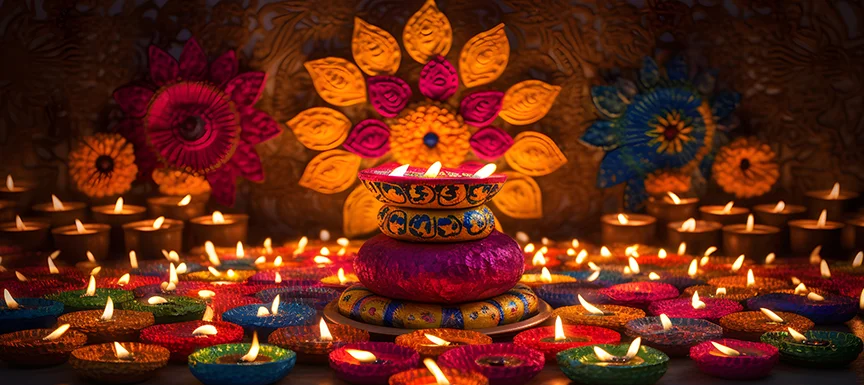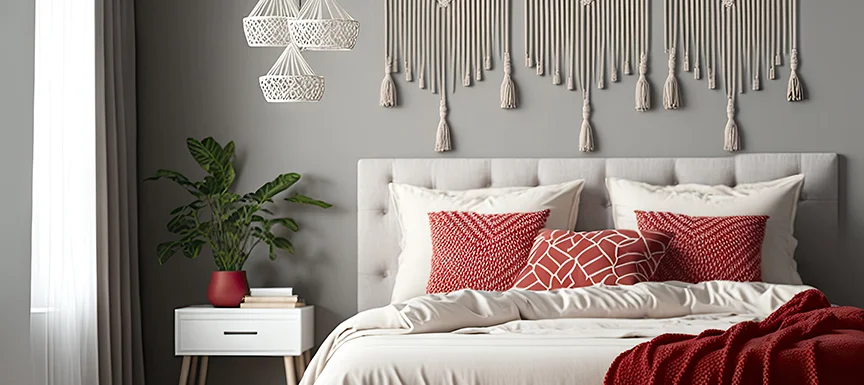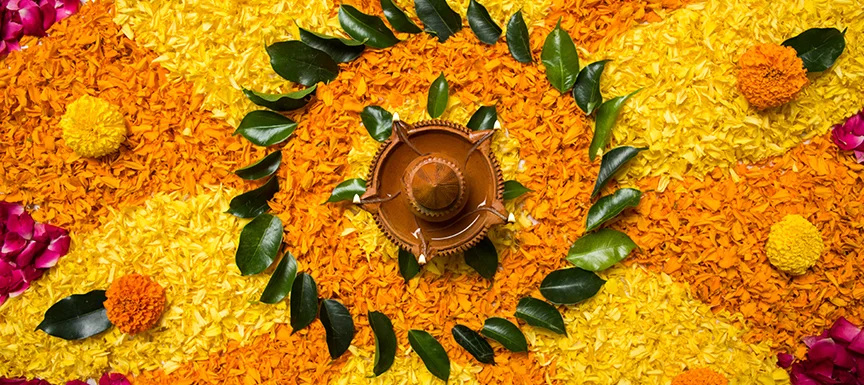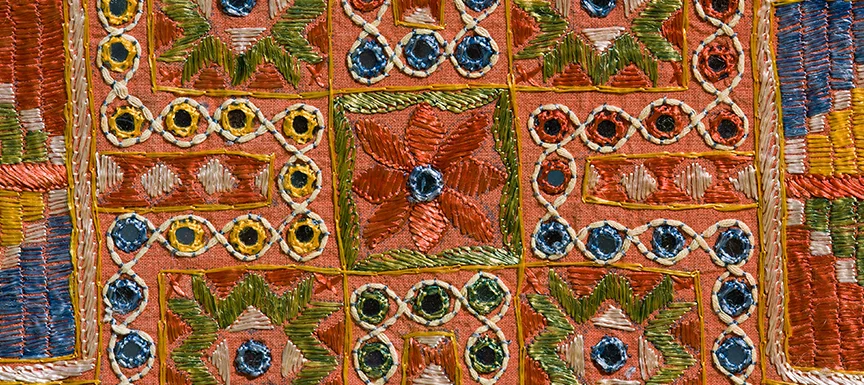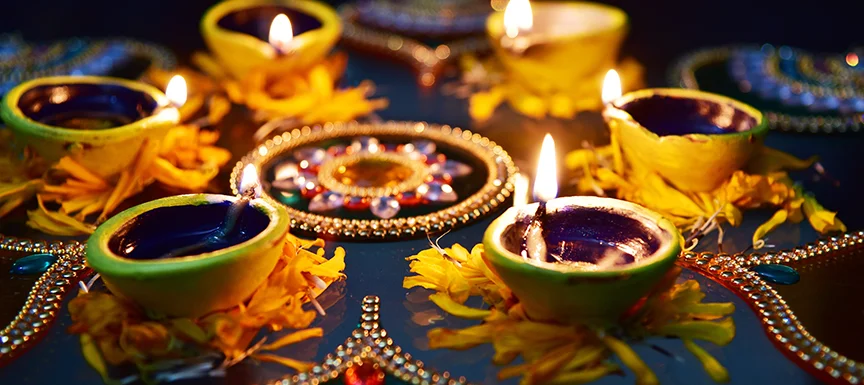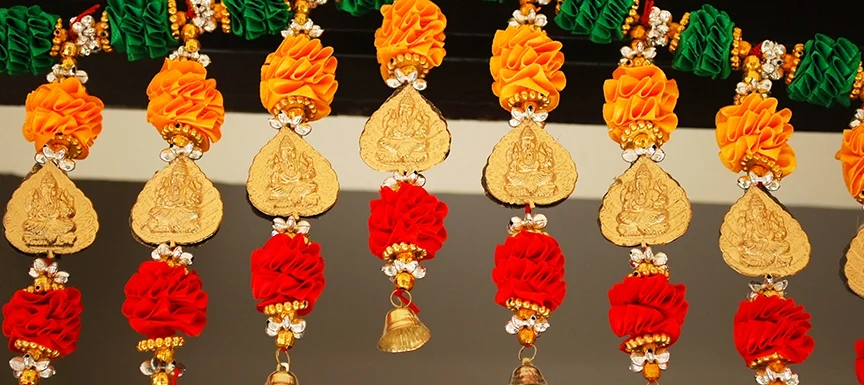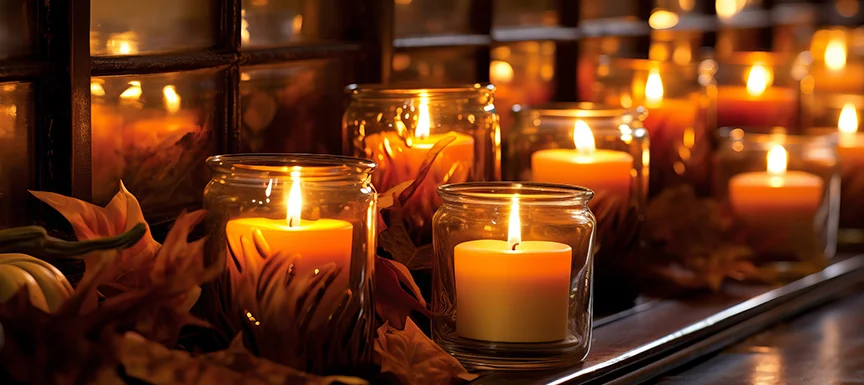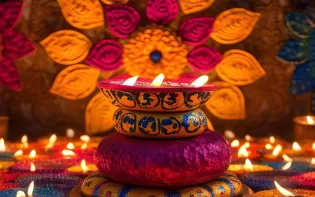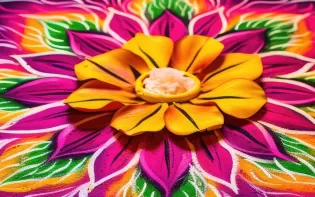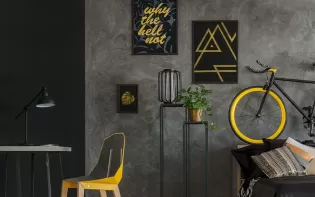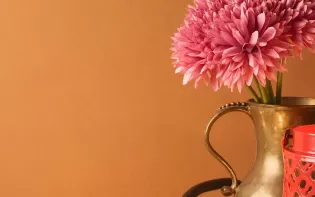What are the best Navratri decoration ideas for small homes?
Begin by designating one puja zone that doubles as a photo corner. Hang a cotton curtain, dupatta, or saree as a backdrop and frame it with marigold strings or paper torans. Raise the idol on a low wooden bajot or a sturdy tray placed on a small stool so offerings sit at a comfortable height while the floor stays free for rangoli. Add a compact diya cluster and one string of warm LEDs routed neatly along the frame. Choose two accent colours and repeat them in cushions, runners, and planters so the home reads cohesive. Borrow greenery from balconies to soften the scene. Keep a small tray for matchsticks, incense, and a lighter so preparation is quick. At the end of each day, shake out petals into a compost bin, coil the lights, and cover the idol with a clean cloth to keep dust away.
How do I decorate my office for Navratri in a simple way?
Focus on shared areas such as reception, the pantry entrance, or one meeting wall so visibility is high but walkways remain clear. Hang fabric buntings and paper torans that are light and easy to remove. Build a desk friendly mandap on a brass or steel plate with a small diya and a flower bowl. Avoid strong incense and loud speakers that might disturb colleagues or sensitive equipment. If your team follows a colour of the day, display a small board that lists the hues for the week. Create one photo corner using a collapsible stand and a solid fabric backdrop that matches the daily palette. Use rechargeable LED tealights for safety. Assign a rotation for tidying petals and replacing flowers so upkeep remains light. Keep all hooks, tape, and extra bulbs in a labelled box at the reception for quick fixes.
What colours are best for Navratri decoration at home?
Pick a simple palette that supports daily outfits and flowers without clashing with furniture. Warm whites, saffron, crimson, rani pink, peacock blue, and leafy green feel festive and photograph well under evening lights. If you follow the nine colour tradition, keep walls neutral and switch accents with cushion covers, dupattas, and blooms. Brass and copper add richness without heavy cost and pair beautifully with wood. In compact rooms, limit the palette to one bright accent and two neutrals so the space looks calm rather than crowded. Use the same tones in torans, runners, and diya holders to knit the room together. For homes with modern interiors, pick one saturated festive hue and echo it softly through two pastel accessories to keep the balance.
How can I make Navratri decorations on a budget?
Spend on one anchor piece that sets the tone, such as a metal diya tree, a bell garland, or a reusable fabric backdrop. Repurpose sarees and dupattas as curtains and table runners. Craft torans from coloured card, magazine pages, or fabric offcuts with thread tassels for movement. Use steel plates, katoris, and glasses as candle stands and flower bowls to avoid buying new holders. For rangoli, mix rice flour with turmeric and kumkum or tint common salt with food colour and store it in jars for the week. Borrow plants from balconies to frame the mandap and create height without cost. Save delivery boxes to store decor after the festival, but line them with cloth to prevent moisture damage. By choosing multipurpose items and avoiding single-use plastic, you achieve a richer look for less money and less waste.
How do I decorate the Navratri mandap at home?
Start with safety and structure. Place the mandap on a stable surface away from curtains and electrical cords. Use a wooden or metal frame wrapped in fabric, or a ready backdrop stand weighted with sandbags. Keep the idol at eye level when seated so aarti feels comfortable. Layer a base cloth, then a narrow runner that catches petals and ash for easy cleaning. Frame the area with torans and two slim garlands rather than heavy bunches to reduce weight and heat near lamps. Position one focal diya cluster and two small flower bowls at the front corners. If space permits, lay a thin rangoli strip to define the zone without blocking movement. Route LED wires along edges and tape them discreetly. Keep a small fire-resistant mat under the diya and a water spray bottle nearby as a basic safety measure.
What traditional items should I include in Navratri decorations?
A classic setup includes a bell, a conch, brass or copper diyas, an incense holder, and a kalash with mango leaves and a coconut. Use a bajot or chowki to raise the idol and keep offerings off the floor. Hang a mango leaf toran or a floral variant at the door to signal welcome. Place a simple rangoli at the entrance for guests. Keep a clean cloth for the idol, a small hand fan, a covered box for kumkum and haldi, and a cloth bag for prasad distribution. Many families also like a ghungroo strand or small bells for sound. These items are functional and symbolic, and they create a timeless look that adapts to both traditional and modern interiors. Store them carefully after the festival so they last for years.
Can I use modern décor elements for Navratri?
Yes. Modern elements can make setup quicker and safer while keeping cultural warmth. Try laser-cut paper backdrops that fold flat, acrylic rangoli tiles that interlock, or magnetic string lights that mount without drilling. Pair matte metal planters or lanterns with traditional brass to balance old and new. Use wireless LED diyas where flames are risky, especially around children and pets, and prefer warm white so the light remains gentle.
A neutral linen backdrop with one bold colour band looks contemporary yet respectful. Smart plugs can schedule lights for aarti time so you do not manually switch them each day. Keep proportions simple and let the idol, flowers, and diya be the visual centre. The result feels current, safe, and easy to maintain across nine festive days.
How do I decorate doorways for Navratri?
Doorways set the tone, so keep them clean and free of obstructions. Hang a toran of mango leaves, marigolds, or a reusable fabric version that will not shed into the corridor. Add a small bell or ghungroo strand at one side to bring a gentle festive sound. Place a compact rangoli plate on the floor and secure it with double-sided tape so it does not shift when the door opens. In narrow passages, avoid bulky hangings that can brush against people or block the latch and peephole.
For the evening, trace the frame with a short LED string and hide the battery pack behind a planter. If your society allows, mark the common lobby with a small welcome placard that lists aarti timings so neighbours can join. Always confirm the building rules and fire safety guidelines before fixing anything in shared spaces.
How can I use flowers for Navratri decoration?
Plan flowers around your schedule and the weather. Marigold and chrysanthemum last longer in warm conditions, while rose and jasmine suit cooler evenings. String garlands the night before and store them in a sealed box in the fridge lined with paper to absorb moisture. Float petals in small bowls of water to keep them fresh through the day. Rotate colours to match daily themes or stay with a single tone if you prefer a calm look. Mix balcony leaves or herbs such as tulsi with purchased flowers to stretch the budget and add fragrance. After aarti, refresh the bowls by trimming stems and changing water. At day end of the day, compost wilted flowers or use them as mulch for potted plants. Avoid floral foam because it is not eco-friendly and can be replaced by a simple water bowl or a reusable grid.
What are eco-friendly Navratri decoration ideas?
Focus on natural and reusable materials. Choose cotton and jute fabrics, metal or clay diyas, paper torans, and wooden frames. Replace plastic glitter with real leaves, seeds, cones, and pressed flowers fixed with thread or natural glue. Power lights with rechargeable batteries or small solar packs where possible. Borrow or share decor within your building so items serve multiple homes, and set up a swap box for spare bells, fabrics, or lamps.
Avoid single-use plastic plates for prasad, and serve water in steel or glass dispensers. Segregate waste, compost petals, and dry and store all reusable pieces in labelled cloth bags to reduce next year’s purchases. By keeping materials repairable and straightforward, you lower cost, limit clutter, and honour the festival with mindful choices.


